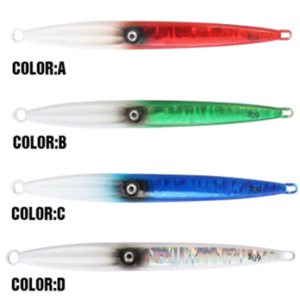New Casting Metal Jigging Lures 3d Eyes Tungsten Deep Sea Jig Isca Slow Pitch Jigs Fast Sinking Decoy
Informasi Tambahan
| Warna | optional |
|---|---|
| Material | Lead, metal |
| Weight | 40g,60g,80g,100g,150g,200g |
| Model | TX-22 |
| Package | PVC Bag |
Product Details:
Metal jig fishing has transformed into a favorite technique for anglers worldwide, thanks to its adaptability, effectiveness, and ease of use. Metal jigs, designed for rapid descent and lifelike movement, attract a wide range of species from deep-sea predators to inshore game fish. This guide provides an in-depth look at metal jig fishing, from understanding why metal jigs are so effective to selecting the right gear, mastering advanced jigging techniques, and ensuring safety on the water. Whether you’re new to jig fishing or looking to refine your skills, this comprehensive guide will elevate your experience.
Why Metal Jigs Should Be in Every Angler’s Tackle Box
Metal jigs have unique features that make them essential for any fishing setup. Here’s why every angler should have a range of metal jigs:
- Rapid Descent: Metal jigs are dense and sink quickly, making them ideal for deep waters, fast currents, or getting into the strike zone rapidly.
- Versatile Action: When jigged correctly, metal jigs mimic the erratic movements of wounded baitfish, which naturally attract predatory fish looking for an easy meal.
- Durability in Harsh Conditions: Made from durable metals, these jigs can withstand rugged underwater terrain and repeated strikes from aggressive fish.
- Appealing to Multiple Species: Metal jigs attract various species, from bottom-dwellers like grouper to pelagic species like tuna, making them ideal for multi-species fishing.
- Simple and Accessible for All Anglers: Metal jigs are easy to use, making them an excellent choice for beginners and a trusted favorite for experienced anglers.
Choosing the Perfect Metal Jig: Key Factors to Consider
When selecting the right jig for your fishing needs, keep these crucial factors in mind:
- Weight:
- Light Jigs (20g – 60g): Best suited for shallow waters, light jigs sink slower and create a gentle flutter that’s attractive to surface feeders in calm conditions.
- Medium Jigs (60g – 150g): These versatile jigs are suitable for a range of depths and conditions, making them an ideal choice for general jigging.
- Heavy Jigs (150g – 300g+): Heavier jigs are essential for deep-water fishing or strong currents, allowing quick access to bottom-dwelling fish and large pelagics.
- Shape:
- Slim, Streamlined Jigs: Designed for fast vertical drops and high-speed jigging, slim jigs minimize water resistance, making them ideal for deep-sea fishing.
- Wide, Flat-Sided Jigs: These jigs have a slower, fluttering descent, perfect for mimicking wounded baitfish. They’re effective for bottom-feeding fish and inshore species.
- Curved or Asymmetrical Jigs: With unpredictable, erratic movements, curved jigs are great for creating lifelike, distressed motions that appeal to predatory fish.
- Color and Finish:
- Metallic and Reflective Colors (Silver, Gold): Reflective colors work well in clear waters, imitating the shimmer of baitfish in bright conditions.
- UV or Glow-in-the-Dark Finishes: Perfect for deep-sea fishing or low-light conditions, these finishes enhance visibility and attract fish from greater distances.
- Natural Colors: Earthy, natural tones work well in clear, shallow waters, mimicking baitfish and helping in highly pressured fishing environments.
- Hooks:
- Assist Hooks: Often attached to metal jigs, these hooks increase hook-up rates, especially with predatory species. Make sure they’re high-quality, sharp, and resistant to corrosion.
- Split Ring and Swivel Quality: Choose durable, strong split rings and swivels to prevent equipment failure when targeting larger, aggressive species.
Mastering Jigging Techniques for Maximum Success
Effective jigging techniques are essential for attracting and landing fish. Here are the top methods to master:
- Vertical Jigging:
- How It Works: Drop the jig directly below the boat to the bottom, then lift and drop the rod in a rhythmic motion to mimic a struggling baitfish.
- Ideal For: Bottom-dwellers like snapper, cod, and grouper, as well as mid-water predators.
- Pro Tip: A fast-action rod with a high-speed reel can help you maintain control over the jig in deeper waters.
- High-Speed Jigging:
- How It Works: Retrieve the jig at high speed with quick, sharp jerks. This erratic action mimics a fleeing baitfish, triggering a predatory response.
- Ideal For: Fast-swimming pelagic fish such as tuna, mackerel, and amberjack.
- Pro Tip: Use a reel with a high gear ratio and braided line to keep up with the fast pace and maintain direct contact with the jig.
- Slow-Pitch Jigging:
- How It Works: Use gentle, rhythmic rod lifts to create a slow fluttering action, letting the jig fall horizontally in between pulls. This technique works well for coaxing bites from cautious fish.
- Ideal For: Bottom-feeding species like grouper and snapper in deeper waters.
- Pro Tip: Use specialized slow-pitch rods to better control the jig’s subtle movements.
- Long Drop Jigging:
- How It Works: Drop the jig to a specific depth, then retrieve slowly with occasional twitches, creating a dying baitfish action.
- Ideal For: Cautious or less aggressive fish in deeper waters.
- Pro Tip: This technique is especially useful in colder conditions or when fish are less active.
- Casting and Retrieving:
- How It Works: Cast the jig into shallow or mid-depth waters and retrieve with a combination of pauses and twitches. It’s effective when fish are feeding near structures like reefs or wrecks.
- Ideal For: Species like bass, trout, and redfish that frequent shallower waters.
- Pro Tip: Light jigs with slow retrieves work well, especially when fishing around visible structure.
Prime Locations for Metal Jig Fishing
Metal jigs can be used in diverse locations for targeting multiple species. Here’s where to use them for maximum success:
- Offshore Deep-Water Spots: Metal jigs are essential for deep-sea fishing, allowing you to reach bottom-dwelling fish like snapper and grouper quickly.
- Reefs and Wrecks: Fish tend to gather around these structures for protection and food. Vertical and slow-pitch jigging work exceptionally well here for reef species.
- Strong Current Areas: When fishing in areas with strong currents, heavy metal jigs allow you to stay in the strike zone and prevent the jig from drifting too far.
- Open Ocean for Pelagic Fish: When targeting fast pelagic species, metal jigs can be cast and quickly retrieved, mimicking fleeing prey. High-speed jigging is especially effective here.
- Shallow Flats and Estuaries: While often overlooked, metal jigs can be used in shallower areas. Lighter jigs with a gentle retrieve are effective for species like trout, bass, and snook.
Setting Up the Ideal Jigging Gear
The right gear setup can make or break your jigging success. Here’s what to consider:
- Rod:
- Fast-Action Rod: A fast-action rod allows for quick hooksets and better jig control.
- Slow-Pitch Rod: For slow-pitch jigging, a flexible rod with a sensitive tip works best, allowing you to finesse the jig’s action.
- Reel:
- High-Speed Reel: A reel with a high gear ratio (6:1 or higher) is ideal for high-speed and vertical jigging.
- Low-Gear, High-Torque Reel: For deep jigging or slow-pitch, a reel with low gear but high torque helps retrieve heavy jigs and tackle deep-water fish.
- Line:
- Braided Line: Thin, strong, and sensitive, braided line is the preferred choice for jigging, providing excellent feedback and hook-setting power.
- Leader: Attach a fluorocarbon or monofilament leader to reduce visibility and absorb shock from aggressive strikes.
- Accessories:
- Split Ring Pliers: Essential for attaching and replacing hooks without damaging the rings.
- Assist Hooks: Use quality assist hooks attached to a split ring on the jig’s eyelet for improved hook-up rates.
Safety Tips for Metal Jig Fishing
Safety is essential when jigging, especially with heavy jigs and strong fish. Here are some precautions to follow:
- Wear Gloves: Jigging often requires handling sharp hooks and can be rough on your hands, so wear gloves for added protection.
- Use a Rod Harness for Heavy Jigs: When jigging for large fish, a rod harness can reduce strain on your arms and back, especially with heavy jigs.
- Mind the Hooks: When casting or handling the jig, always be cautious of sharp hooks and make sure they’re secure to avoid
Produk Terkait
-

Metal Jig Fishing Lure Slow Cast Jigging Spoon colorful Artificial Shore Metal Bait Sea Tackle
-

Laser Coating Cast Jig with Hooks for Saltwater Colorful Metal Lead Bait for Boat Fishing Lure
-

Flat-Side Jigs Fishing Metal Jig Lure Saltwater Lure Fish Lure Tuna Shore Jig For Sale 60-400G
-

Saltwater Jigs Fishing Lures










